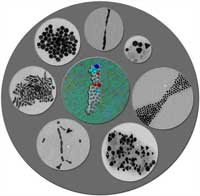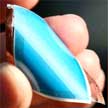Showing Spotlights 33 - 40 of 40 in category All (newest first):
 Liquid crystal displays (LCD) have become an integral part of our everyday life. LCDs are everywhere, on your digital watches, cameras, iPods, laptop computers, television screens or car navigation displays. LCDs get their name from the special liquid crystal solution that is contained between two thin glass plates inside the display. Recent research findings suggest that embedding doped metal nanoparticles (MNP) in liquid crystal materials increases the performance of certain display devices. So far, however, the main problem with this approach has been that the inclusion of nanoparticles destabilizes the LC material. Researchers have now succeeded in synthesizing metal nanoparticle embedded stable liquid crystals in a single step, without using any external reducing and stabilizing agents. As a bottom-up strategy, this work is a further step towards synthesizing three-dimensional macro structures using small nanoparticles as building blocks, and an elegant method in fabricating soft organic architectures; particularly when it is combined with electronic, magnetic or photonic properties of inorganic materials.
Liquid crystal displays (LCD) have become an integral part of our everyday life. LCDs are everywhere, on your digital watches, cameras, iPods, laptop computers, television screens or car navigation displays. LCDs get their name from the special liquid crystal solution that is contained between two thin glass plates inside the display. Recent research findings suggest that embedding doped metal nanoparticles (MNP) in liquid crystal materials increases the performance of certain display devices. So far, however, the main problem with this approach has been that the inclusion of nanoparticles destabilizes the LC material. Researchers have now succeeded in synthesizing metal nanoparticle embedded stable liquid crystals in a single step, without using any external reducing and stabilizing agents. As a bottom-up strategy, this work is a further step towards synthesizing three-dimensional macro structures using small nanoparticles as building blocks, and an elegant method in fabricating soft organic architectures; particularly when it is combined with electronic, magnetic or photonic properties of inorganic materials.
May 4th, 2007
 Imagine a toothpaste that not only seeks out but actually repairs damage to tooth enamel. For those who dread their annual visit to the dentist, this may sound like science fiction. For people in Japan, it is a reality. Using nanoparticles, Japan's Sangi Company, Ltd., has sold more than 50 million tubes - and continues to expand its line of products containing nanoparticles. Scientists have learned to synthesize hydroxyapatite, a key component of tooth enamel, as nanosized crystals. When nano-hydroxyapatite is used in toothpaste, it forms a protective film on tooth enamel, and even restores the surface in damaged areas. Availability of similar products that claim to actually repair cavities is just around the corner. Unlikely as it seems at first blush, the $200 billion global cosmetics industry is one of the major players in the emerging field of nanotechnology. According to the Centre for the Study of Environmental Change at Lancaster University in Britain, the cosmetics industry already holds the largest number of patents for nanoparticles - and be it toothpaste, sunscreen, shampoo, hair conditioner, lipstick, eye shadow, after shave, moisturizer or deodorant, the industry is leading the way.
Imagine a toothpaste that not only seeks out but actually repairs damage to tooth enamel. For those who dread their annual visit to the dentist, this may sound like science fiction. For people in Japan, it is a reality. Using nanoparticles, Japan's Sangi Company, Ltd., has sold more than 50 million tubes - and continues to expand its line of products containing nanoparticles. Scientists have learned to synthesize hydroxyapatite, a key component of tooth enamel, as nanosized crystals. When nano-hydroxyapatite is used in toothpaste, it forms a protective film on tooth enamel, and even restores the surface in damaged areas. Availability of similar products that claim to actually repair cavities is just around the corner. Unlikely as it seems at first blush, the $200 billion global cosmetics industry is one of the major players in the emerging field of nanotechnology. According to the Centre for the Study of Environmental Change at Lancaster University in Britain, the cosmetics industry already holds the largest number of patents for nanoparticles - and be it toothpaste, sunscreen, shampoo, hair conditioner, lipstick, eye shadow, after shave, moisturizer or deodorant, the industry is leading the way.
Dec 4th, 2006
 Zinc oxide (ZnO) is considered a workhorse of technological development exhibiting excellent electrical, optical, and chemical properties with a broad range of applications as semiconductors, in optical devices, piezoelectric devices, surface acoustic wave devices, sensors, transparent electrodes, solar cells, antibacterial activity etc. Thin films or nanoscale coating of ZnO nanoparticles on suitable substrates are viewed with great interest for their potential applications as substrates for functional coating, printing, UV inks, e-print, optical communication (security-papers), protection, barriers, portable energy, sensors, photocatalytic wallpaper with antibacterial activity etc. Various methods like chemical, thermal, spin coating, spray pyrolysis, pulsed laser deposition have been used for thin film formation but they are limited to solid supports such as metal, metal oxides, glass or other thermally stable substrates. Coating of ZnO nanoparticles on thermolabile surfaces is scarce and coating on paper was yet to be reported. Paper as a substrate is an economic alternative for technological applications having desired portability and flexibility. Researchers from the National Tsing Hua University in Taiwan found a way of coating paper with ZnO nanoparticles using ultrasound.
Zinc oxide (ZnO) is considered a workhorse of technological development exhibiting excellent electrical, optical, and chemical properties with a broad range of applications as semiconductors, in optical devices, piezoelectric devices, surface acoustic wave devices, sensors, transparent electrodes, solar cells, antibacterial activity etc. Thin films or nanoscale coating of ZnO nanoparticles on suitable substrates are viewed with great interest for their potential applications as substrates for functional coating, printing, UV inks, e-print, optical communication (security-papers), protection, barriers, portable energy, sensors, photocatalytic wallpaper with antibacterial activity etc. Various methods like chemical, thermal, spin coating, spray pyrolysis, pulsed laser deposition have been used for thin film formation but they are limited to solid supports such as metal, metal oxides, glass or other thermally stable substrates. Coating of ZnO nanoparticles on thermolabile surfaces is scarce and coating on paper was yet to be reported. Paper as a substrate is an economic alternative for technological applications having desired portability and flexibility. Researchers from the National Tsing Hua University in Taiwan found a way of coating paper with ZnO nanoparticles using ultrasound.
Nov 16th, 2006
 With the advent of nanoscience and technology, a new area has developed in the area of textile finishing called "Nanofinishing". Growing awareness of health and hygiene has increased the demand for bioactive or antimicrobial and UV-protecting textiles. Coating the surface of textiles and clothing with nanoparticles is an approach to the production of highly active surfaces to have UV blocking, antimicrobial, flame retardant, water repellant and self-cleaning properties. While antimicrobial properties are exerted by nano-silver, UV blocking, self-cleaning and flame-retardant properties are imparted by nano-metal oxide coatings. Zinc oxide (ZnO) nanoparticles embedded in polymer matrices like soluble starch are a good example of functional nanostructures with potential for applications such as UV-protection ability in textiles and sunscreens, and antibacterial finishes in medical textiles and inner wears.
With the advent of nanoscience and technology, a new area has developed in the area of textile finishing called "Nanofinishing". Growing awareness of health and hygiene has increased the demand for bioactive or antimicrobial and UV-protecting textiles. Coating the surface of textiles and clothing with nanoparticles is an approach to the production of highly active surfaces to have UV blocking, antimicrobial, flame retardant, water repellant and self-cleaning properties. While antimicrobial properties are exerted by nano-silver, UV blocking, self-cleaning and flame-retardant properties are imparted by nano-metal oxide coatings. Zinc oxide (ZnO) nanoparticles embedded in polymer matrices like soluble starch are a good example of functional nanostructures with potential for applications such as UV-protection ability in textiles and sunscreens, and antibacterial finishes in medical textiles and inner wears.
Oct 13th, 2006
 The discussion about the health scare caused by the Magic-Nano sealing spray (which, as it turned out, was neither magic nor nano - see this article) has barely ebbed when questions about another nano consumer product arise. This time, it is not a health scare but rather the opposite - alleged health benefits of nanoparticles.
The discussion about the health scare caused by the Magic-Nano sealing spray (which, as it turned out, was neither magic nor nano - see this article) has barely ebbed when questions about another nano consumer product arise. This time, it is not a health scare but rather the opposite - alleged health benefits of nanoparticles.
Aug 8th, 2006
 The use of nanoparticles in sunscreens is one of the most common uses of nanotechnology in consumer products. Well over 300 sunscreens on the market today contain zinc oxide or titanium oxide nanoparticles.
The use of nanoparticles in sunscreens is one of the most common uses of nanotechnology in consumer products. Well over 300 sunscreens on the market today contain zinc oxide or titanium oxide nanoparticles.
Aug 3rd, 2006
 An electrochromic display is one of the most attractive candidates for paper-like displays, so called electronic paper, which will be the next generation display, owing to attributes such as thin and flexible materials, low-power consumption, and fast switching times.
An electrochromic display is one of the most attractive candidates for paper-like displays, so called electronic paper, which will be the next generation display, owing to attributes such as thin and flexible materials, low-power consumption, and fast switching times.
Jun 19th, 2006
 Researchers have turned to carbon nanotubes to create a new class of large area, high resolution, low cost flat panel displays. Some believe field emission display (FED) technology, utilizing carbon nanotubes (CNT) as electron emitter, will be the biggest threat to LCD's dominance in the panel display arena.
Researchers have turned to carbon nanotubes to create a new class of large area, high resolution, low cost flat panel displays. Some believe field emission display (FED) technology, utilizing carbon nanotubes (CNT) as electron emitter, will be the biggest threat to LCD's dominance in the panel display arena.
Mar 2nd, 2006
 Liquid crystal displays (LCD) have become an integral part of our everyday life. LCDs are everywhere, on your digital watches, cameras, iPods, laptop computers, television screens or car navigation displays. LCDs get their name from the special liquid crystal solution that is contained between two thin glass plates inside the display. Recent research findings suggest that embedding doped metal nanoparticles (MNP) in liquid crystal materials increases the performance of certain display devices. So far, however, the main problem with this approach has been that the inclusion of nanoparticles destabilizes the LC material. Researchers have now succeeded in synthesizing metal nanoparticle embedded stable liquid crystals in a single step, without using any external reducing and stabilizing agents. As a bottom-up strategy, this work is a further step towards synthesizing three-dimensional macro structures using small nanoparticles as building blocks, and an elegant method in fabricating soft organic architectures; particularly when it is combined with electronic, magnetic or photonic properties of inorganic materials.
Liquid crystal displays (LCD) have become an integral part of our everyday life. LCDs are everywhere, on your digital watches, cameras, iPods, laptop computers, television screens or car navigation displays. LCDs get their name from the special liquid crystal solution that is contained between two thin glass plates inside the display. Recent research findings suggest that embedding doped metal nanoparticles (MNP) in liquid crystal materials increases the performance of certain display devices. So far, however, the main problem with this approach has been that the inclusion of nanoparticles destabilizes the LC material. Researchers have now succeeded in synthesizing metal nanoparticle embedded stable liquid crystals in a single step, without using any external reducing and stabilizing agents. As a bottom-up strategy, this work is a further step towards synthesizing three-dimensional macro structures using small nanoparticles as building blocks, and an elegant method in fabricating soft organic architectures; particularly when it is combined with electronic, magnetic or photonic properties of inorganic materials.
 Subscribe to our Nanotechnology Spotlight feed
Subscribe to our Nanotechnology Spotlight feed

